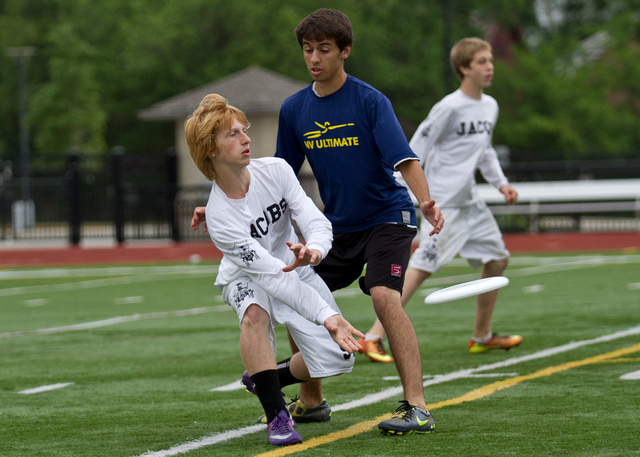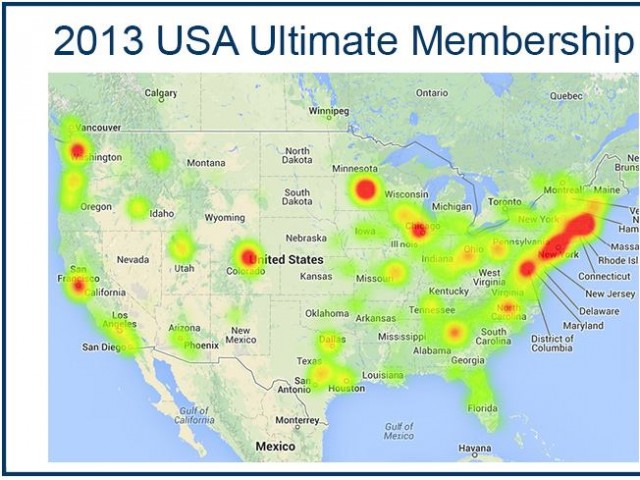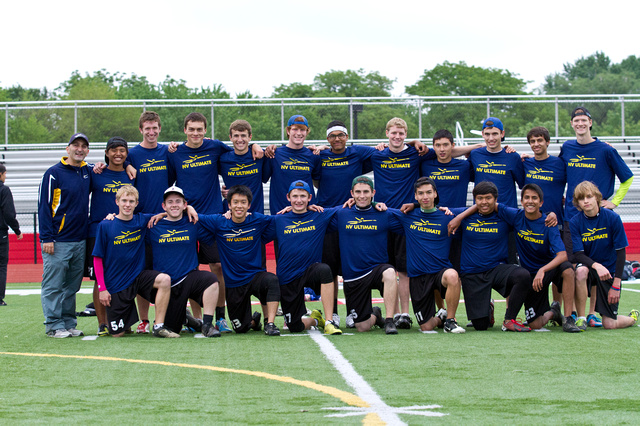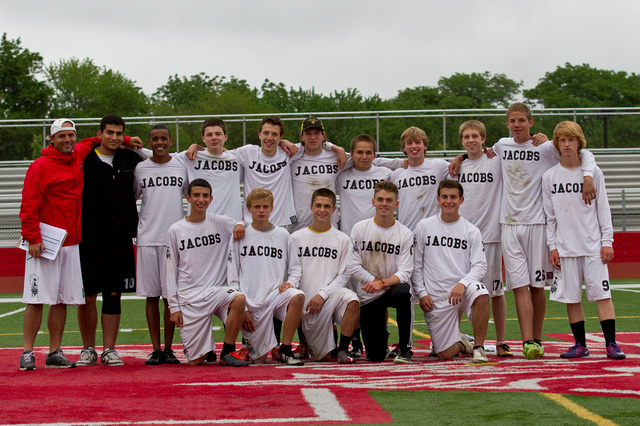 Nick Lindeke - UltiPhotos.com
Nick Lindeke - UltiPhotos.com
Chicago has population of almost 3 million people (triple that if the surrounding suburbs are counted) and is a growing hotspot for ultimate, with thriving colleges, clubs, and a new pro team. And yet this bustling Midwest hub still isn’t considered by many to be “an ultimate city.”
And yet, the culture for ultimate, largely based on the youth, is expanding, and the potential is enormous, as many young players hope to change that label.

Photo courtesy of USA Ultimate
Two schools that many point to as a sign of this growth are Neuqua Valley High School in Naperville and Harry D. Jacobs High School in Algonquin. Both are considered to be top high school programs in the state, churning out some of the best young ultimate athletes in the Midwest, kids that are being recruited by YCC teams, colleges, and clubs, and both can claim to have more participants than many college ultimate programs. Each school is relatively recent in its rise and each is run by a dynamic head coach and organizer with an impressive (and counting) ultimate resume. But the most interesting thing about these two youth-builders is that neither was seriously involved with ultimate before stepping up to start a team at their respective school.
Neuqua Valley High School, of the large southern suburb of Chicago, is a big program with a great coach, Arnoush Javaherian.

Nick Lindeke – UltiPhotos.com
“Java,” as he is known in the ultimate world, has an impressive resume grown since 2008; he is the current president of Illinois Youth Ultimate (IYU) a recently created organization for youth in the state, the founder/director of CUT (Chicago Ultimate Training) camp, minority owner of Chicago Wildfire of the AUDL, an organizer of two tournaments (an indoor and a beach tourney), and an instructor for USAU Level 1 clinics. But this essential figure in Midwestern ultimate had a relatively quiet start to his ultimate career and never received real recognition for his playing. Java learned about the sport in high school and loved it so much that as a summer camp counselor he led the charge for it to be played. “I became obsessed with it quickly,” he says. “I went out for it in college but did not stick with it and it is actually one of my big regrets in life.” Java was involved with the game at his camp and at various leagues around Wisconsin before finding his greatest passion: building the powerhouse program that is Neuqua Valley Ultimate. “In 2007, my first year of teaching, I wanted to help out with the ultimate club at my new high school,” says Java. “I was thinking a school of this size– over 4,000 students– would have a club already. To my surprise there wasn’t one yet.” Java was contacted by an interested student and the club began with good numbers. Slowly, it built up, gathering more interest until it became a year round sport that started to create its own local leagues and camps.
Today, Neuqua has over 200 players within its “club”: five high school open teams, one rapidly growing girls team, and over 21 coaches, many of them outside volunteers from the area or even from the top Men’s club team Chicago Machine. The club has a board of directors now, a number of parent and staff volunteers, and two part-time administrative assistants. There is a youth division (4th-8th) within it that is churning out 38 freshman ultimate players into Neuqua this year. Naperville, in no small part thanks to Java, has become its own little center of ultimate in the suburbs.
So how did one high school go from no club to over 200 players in just 6 short years? How did one coach become so integrally involved with the ultimate world of Illinois?
Supply and demand. Java knew ultimate and saw there was a demand. So he supplied opportunities, using his organizational skills, his time, and his passion to provide the kids with everything and more.
“Provide plenty of opportunities for your players,” Java explains. “This includes leagues, tournaments, and anything else you can do. I know it requires more time and effort on your part and perhaps weekends away from your family, but the payoff is amazing as the players will be that much more invested.”
Java emphasizes patience and long-term planning to get young people hooked on ultimate. He says all that incredible effort and work, to give every kid- he tries to exclude no one- these opportunities will be worth it if they can walk away with so many learning and playing experiences in the sport.

Nick Lindeke – UltiPhotos.com
40 miles away, at the edge of the northwest suburbs, lies Algonquin, Illinois, and another great example of youth ultimate in the state. Tony Miocic is the coach of Jacobs High School in Algonquin. He was introduced to the game at the University of Iowa but never played until he joined a fall league after college. Tony is a high school counselor who likes getting kids involved in extracurriculars. It was his creation of an inter-school tournament that eventually sparked the team. Similar to Java, at the high school where Tony worked, he saw a lack of youth ultimate and knew a club would be a perfect way to fill it. “I realized there was a fairly large gap waiting to be filled at the youth level,” he tells Skyd. “I started gathering interested kids [in 2008] and began our program at Jacobs.” Slowly, Jacobs grew and joined various leagues and tournaments, Tony and the kids learning more as they went. Today, they have over 45 players and field two teams with the help of 3 to 4 other coaches, and are one of the top contenders in the midwest.
Tony is another example of a great program-builder with limited playing experience, but incredible dedication to provide so much for his athletes. He works hard for his kids- reaching out to parents, administration of the school, and the ultimate community, creating his own connections with college, club, and pro teams. Algonquin, as a suburb, is far from the Chicago, so when he can’t use the ultimate resources based in the city, he creates his own.
“We do our own camps, clinics, and leagues up by us. In the summer we host a High School camp where we invite middle school kids and new freshmen to learn the game. Our varsity players will do their own week long camp with club and college players.” The events he creates draw not only youth players, but anyone – elite to newcomer – from the suburbs looking for more ultimate. The most impressive thing about Jacobs might just be their middle-school development. Dundee Middle, one of the feeder schools, has over 70 players of their own. “The DMS program basically started when I decided I wanted my players to give back to the younger community,” Miocic explains. “and gain valuable hours for community service that I know they need for scholarships and college admissions.” He encourages his players to take their love of the sport and give back by teaching kids in the area, and with help of dedicated teachers and coaches at the lower levels, he may have created a system that even surpasses his own. Now kids are coming to him with throwing and playing experience, making his team stronger, and more likely that these players will become the best in the area. “Honestly, the growth of youth ultimate (school based) I think is best started at the middle school level.”
Tony’s advice to organizers is to work hard, but be realistic with expectations and try not to bulldoze your way into school culture. Use the resources you have and create your own using people that are eager to help. He and others like him are key examples of why everyday sports enthusiasts- and non-diehard ultimate players- can become excellent coaches and organizers.
Why is ultimate growing? The majority point to youth ultimate as the answer.
USA Ultimate has made youth development priority number one because several different groups of people- students, parents, coaches, teachers, and volunteers- can introduce and organize the sport for new players in a lot of different environments. Younger, enthusiastic generations are the prime target for the sport, ready to expand it on all fronts, and turn ultimate into something recognized by all worldwide.
More and more kids are learning ultimate at an age comparable to when they would learn the games of basketball or baseball; youth ultimate leagues, programs, and introductions into schools are increasing in number. In short, more kids are playing ultimate, and to most people, this is a good thing as it grows the sport.
But how does it happen successfully? Informing and bringing in athletes in high school can be a challenge, especially with pressures and draws from a variety of more mainstream sports and what they offer; colleges are often battling a large amount of factors to recruit, teach, and keep new players. And yet, some high school programs are thriving. When you look at the people spending their time, effort, and passion to help these programs…it becomes clear why.
Miocic and Java are great examples of dedicated coaches, and their programs should be models for other organizers around the country. Their methods and advice can be the keys to not only introduce the sport to thousands of kids who might not have been exposed to it, but to keep these kids playing and shaping the future of ultimate.
“What’s most important is finding someone passionate about providing students with a unique, exciting, and fun experience,” Miocic says. “My middle school program is being run by one of the most dynamic, energetic, and athletic people who had little to no ultimate experience before we did our middle school outreach. We taught him at the same time we taught the kids. He’s grown it into something special. Not because he played for Machine, but because he cares about the students and now cares about the sport.”
For advice or questions about these two or their programs email:








Comments Policy: At Skyd, we value all legitimate contributions to the discussion of ultimate. However, please ensure your input is respectful. Hateful, slanderous, or disrespectful comments will be deleted. For grammatical, factual, and typographic errors, instead of leaving a comment, please e-mail our editors directly at editors [at] skydmagazine.com.